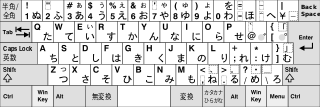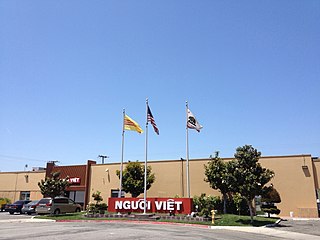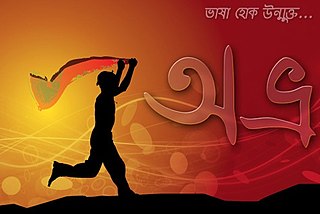Related Research Articles
OpenType is a format for scalable computer fonts. Derived from TrueType, it retains TrueType's basic structure but adds many intricate data structures for describing typographic behavior. OpenType is a registered trademark of Microsoft Corporation.

The letter F with hook is a letter of the Latin script, based on the italic form of f; or on its regular form with a descender hook added. A very similar-looking letter, ⟨ʄ⟩, is used in the IPA for a voiced palatal implosive.

In relation to the Japanese language and computers many adaptation issues arise, some unique to Japanese and others common to languages which have a very large number of characters. The number of characters needed in order to write in English is quite small, and thus it is possible to use only one byte (28=256 possible values) to encode each English character. However, the number of characters in Japanese is many more than 256 and thus cannot be encoded using a single byte - Japanese is thus encoded using two or more bytes, in a so-called "double byte" or "multi-byte" encoding. Problems that arise relate to transliteration and romanization, character encoding, and input of Japanese text.
VISCII is an unofficially-defined modified ASCII character encoding for using the Vietnamese language with computers. It should not be confused with the similarly-named officially registered VSCII encoding. VISCII keeps the 95 printable characters of ASCII unmodified, but it replaces 6 of the 33 control characters with printable characters. It adds 128 precomposed characters. Unicode and the Windows-1258 code page are now used for virtually all Vietnamese computer data, but legacy VSCII and VISCII files may need conversion.
The International Alphabet of Sanskrit Transliteration (IAST) is a transliteration scheme that allows the lossless romanisation of Indic scripts as employed by Sanskrit and related Indic languages. It is based on a scheme that emerged during the 19th century from suggestions by Charles Trevelyan, William Jones, Monier Monier-Williams and other scholars, and formalised by the Transliteration Committee of the Geneva Oriental Congress, in September 1894. IAST makes it possible for the reader to read the Indic text unambiguously, exactly as if it were in the original Indic script. It is this faithfulness to the original scripts that accounts for its continuing popularity amongst scholars.
Vietnamese Quoted-Readable, also known as Vietnet, is a convention for writing Vietnamese using ASCII characters encoded in only 7 bits, making possible for Vietnamese to be supported in computing and communication systems at the time. Because the Vietnamese alphabet contains a complex system of diacritical marks, VIQR requires the user to type in a base letter, followed by one or two characters that represent the diacritical marks.
Timeworks Publisher was a desktop publishing (DTP) program produced by GST Software in the United Kingdom and published by Timeworks, Inc., in the United States.

Nguoi Viet Daily News is the first, oldest, and largest daily newspaper published in Vietnamese outside of Vietnam. The name of their newspaper người Việt symbolizes Vietnamese people".
Telex or TELEX, is a convention for encoding Vietnamese text in plain ASCII characters. Originally used for transmitting Vietnamese text over telex systems, it is one of the most used input method on phones and touchscreens and also computers. Vietnamese Morse code uses the TELEX system. Other systems include VNI and VIQR.
VNI Software Company is a developer of various education, entertainment, office, and utility software packages. They are known for developing an encoding and a popular input method for Vietnamese on for computers. VNI is often available on computer systems to type Vietnamese, alongside TELEX input method as well. The most common pairing is the use of VNI on keyboard and computers, whilst TELEX is more common on phones or touchscreens.
VPSKeys is a freeware input method editor developed and distributed by the Vietnamese Professionals Society (VPS). One of the first input method editors for Vietnamese, it allows users to add accent marks to Vietnamese text on computers running Microsoft Windows. The first version of VPSKeys, supporting Windows 3.1, was released in 1993. The most recent version is 4.3, released in October 2007.
Sinhala language software for computers have been present since the late 1980s but no standard character representation system was put in place which resulted in proprietary character representation systems and fonts. In the wake of this CINTEC introduced Sinhala within the UNICODE standard. ICTA concluded the work started by CINTEC for approving and standardizing Sinhala Unicode in Sri Lanka.

Unicode input is method to add a specific Unicode character to a computer file; it is a common way to input characters not directly supported by a physical keyboard. Characters can be entered either by selecting them from a display, by typing a certain sequence of keys on a physical keyboard, or by drawing the symbol by hand on touch-sensitive screen. In contrast to ASCII's 96 element character set, Unicode encodes hundreds of thousands of graphemes (characters) from almost all of the world's written languages and many other signs and symbols besides.

Avro Keyboard is a free and open source graphical keyboard software developed by OmicronLab for the Microsoft Windows, Linux, MacOS, and several other software additionally adapted its phonetic layout for Android and iOS operating system. It is the first free Unicode and ANSI compliant Bengali keyboard interface for Windows. It was published on 26 March 2003.
Bengali input methods refer to different systems developed to type the characters of the Bengali script for Bengali language and others, using a typewriter or a computer keyboard.
The Vietnamese language is written with a Latin script with diacritics which requires several accommodations when typing on phone or computers. Software-based systems are a form of writing Vietnamese on phones or computers with software that can be installed on the device or from third-party software such as UniKey. Telex is the oldest input method devised to encode the Vietnamese language with its tones. Other input methods may also include VNI and VIQR. VNI input method is not to be confused with VNI code page.

UniKey is the most popular third-party software and input method editor (IME) for encoding Vietnamese for Windows. The core, UniKey Vietnamese Input Method, is also the engine imbedded in many Vietnamese software-based keyboards in Windows, Android, Linux, macOS and iOS. UniKey is free and the source code for the UniKey Vietnamese Input Method is distributed under GNU General Public License. The official website of UniKey is unikey.org, which supports both English and Vietnamese.

Vietnamese has more than 1.5 million speakers in the United States, where it is the sixth-most spoken language. The United States also ranks second among countries and territories with the most Vietnamese speakers, behind Vietnam. The Vietnamese language became prevalent after the conclusion of the Vietnam War in 1975, when many refugees from Vietnam came to the United States. It is used in many aspects of life, including media, commerce, and administration. In several states, it is the third-most spoken language, behind English and Spanish. To maintain the language for later generations, Vietnamese speakers have established many language centers and coordinated with public school systems to teach Vietnamese to students who are born and raised in the United States.

Meitei input methods are the methods that allow users of computers to input texts in the Meitei script, systematically for Meitei language.
References
- ↑ LaGanga, Maria L. (June 16, 1989). "Typing in Tongues". Los Angeles Times . p. 5 – via Newspapers.com.
- 1 2 Takahashi, Dean (February 22, 1993). "Keeping Vietnam Language Alive Via Computer". Los Angeles Times . Retrieved July 24, 2022.
- ↑ Mendelson, Edward (June 13, 1989). "Soft Fonts: Less Pain, More Gain". PC Magazine . Vol. 8, no. 11. New York City: Ziff-Davis Publishing Company. p. 240 – via Google Books.